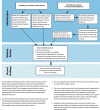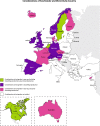Beyond sex and gender difference in funding and reporting of health research
- PMID: 30167330
- PMCID: PMC6112145
- DOI: 10.1186/s41073-018-0050-6
Beyond sex and gender difference in funding and reporting of health research
Abstract
Background: Understanding sex and gender in health research can improve the quality of scholarship and enhance health outcomes. Funding agencies and academic journals are two key gatekeepers of knowledge production and dissemination, including whether and how sex/gender is incorporated into health research. Though attention has been paid to key issues and practices in accounting for sex/gender in health funding agencies and academic journals, to date, there has been no systematic analysis documenting whether and how agencies and journals require attention to sex/gender, what conceptual explanations and practical guidance are given for such inclusion, and whether existing practices reflect the reality that sex/gender cannot be separated from other axes of inequality.
Methods: Our research systematically examines official statements about sex/gender inclusion from 45 national-level funding agencies that fund health research across 36 countries (covering the regions of the EU and associated countries, North America, and Australia) and from ten top-ranking general health (the top five in "science" and the top five in "social science") and ten sex- and/or gender-related health journals. We explore the extent to which agencies and journals require inclusion of sex/gender considerations and to what extent existing strategies reflect state of the art understandings of sex/gender, including intersectional perspectives.
Results: The research highlights the following: (a) there is no consistency in whether sex/gender are mentioned in funding and publishing guidelines; (b) there is wide variation in how sex/gender are conceptualized and how researchers are asked to address the inclusion/exclusion of sex/gender in research; (c) funding agencies tend to prioritize male/female equality in research teams and funding outcomes over considerations of sex/gender in research content and knowledge production; and (d) with very few exceptions, agency and journal criteria fail to recognize the complexity of sex/gender, including the intersection of sex/gender with other key factors that shape health.
Conclusions: The conceptualization and integration of sex/gender needs to better capture the interacting and complex factors that shape health-an imperative that can be informed by an intersectional approach. This can strengthen current efforts to advance scientific excellence in the production and reporting of research. We provide recommendations and supporting questions to strengthen consideration of sex/gender in policies and practices of health journals and funding agencies.
Keywords: Funding agencies; Gender; Health; Health journals; Intersectionality; Knowledge generation; Policy; Scientific reporting; Sex differences; Sex/gender.
Conflict of interest statement
Not applicable.Not applicable.The authors declare that they have no competing interests.Springer Nature remains neutral with regard to jurisdictional claims in published maps and institutional affiliations.
Figures
Similar articles
-
The Integration of Sex and Gender Considerations Into Biomedical Research: Lessons From International Funding Agencies.J Clin Endocrinol Metab. 2021 Sep 27;106(10):3034-3048. doi: 10.1210/clinem/dgab434. J Clin Endocrinol Metab. 2021. PMID: 34137862 Free PMC article.
-
The future of Cochrane Neonatal.Early Hum Dev. 2020 Nov;150:105191. doi: 10.1016/j.earlhumdev.2020.105191. Epub 2020 Sep 12. Early Hum Dev. 2020. PMID: 33036834
-
Beyond the black stump: rapid reviews of health research issues affecting regional, rural and remote Australia.Med J Aust. 2020 Dec;213 Suppl 11:S3-S32.e1. doi: 10.5694/mja2.50881. Med J Aust. 2020. PMID: 33314144
-
How research funding agencies support science integration into policy and practice: an international overview.Implement Sci. 2014 Feb 24;9:28. doi: 10.1186/1748-5908-9-28. Implement Sci. 2014. PMID: 24565209 Free PMC article. Review.
-
The gender and geography of publishing: a review of sex/gender reporting and author representation in leading general medical and global health journals.BMJ Glob Health. 2021 May;6(5):e005672. doi: 10.1136/bmjgh-2021-005672. BMJ Glob Health. 2021. PMID: 33986001 Free PMC article. Review.
Cited by
-
The Integration of Sex and Gender Considerations Into Biomedical Research: Lessons From International Funding Agencies.J Clin Endocrinol Metab. 2021 Sep 27;106(10):3034-3048. doi: 10.1210/clinem/dgab434. J Clin Endocrinol Metab. 2021. PMID: 34137862 Free PMC article.
-
Sex and gender in infection and immunity: addressing the bottlenecks from basic science to public health and clinical applications.R Soc Open Sci. 2023 Jul 5;10(7):221628. doi: 10.1098/rsos.221628. eCollection 2023 Jul. R Soc Open Sci. 2023. PMID: 37416827 Free PMC article.
-
How to carry out participatory research that takes account of sex and gender issues: a scoping review of guidelines targeting health inequities.Can J Public Health. 2023 Jun;114(3):404-421. doi: 10.17269/s41997-023-00742-z. Epub 2023 Feb 8. Can J Public Health. 2023. PMID: 36752980 Free PMC article.
-
Trend of Women's Health Research in Korea, 2012-2020: Topic and Text Network Analysis.J Korean Med Sci. 2023 Jul 31;38(30):e226. doi: 10.3346/jkms.2023.38.e226. J Korean Med Sci. 2023. PMID: 37527909 Free PMC article. Review.
-
Translational Intracerebral Hemorrhage Research: Has Current Neuroprotection Research ARRIVEd at a Standard for Experimental Design and Reporting?Transl Stroke Res. 2020 Dec;11(6):1203-1213. doi: 10.1007/s12975-020-00824-x. Epub 2020 Jun 5. Transl Stroke Res. 2020. PMID: 32504197 Free PMC article.
References
-
- Ritz SA, Antle DM, Côté J, Deroy K, Fraleigh N, Messing K, et al. First steps for integrating sex and gender considerations into basic experimental biomedical research. Feder Am Soc Exp Biol. 2014;28:4–13. - PubMed
LinkOut - more resources
Full Text Sources
Other Literature Sources




